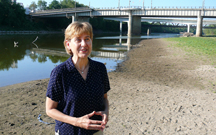Drought challenges communities to plan for weather extremes
July 30, 2012
 |
|
Jane Frankenberger, Purdue Extension water resources
specialist, stands along a portion of the Wabash River in West Lafayette that
normally is under water. The drought has lowered levels of rivers, streams and
lakes across Indiana. (Purdue Agricultural Communication photo/Keith Robinson) |
WEST LAFAYETTE, Ind. - Communities should be mindful of the need to protect citizens from the consequences of extreme weather that include not only too little water but also too much of it, a Purdue Extension water resources specialist says.
"The drought is a wake-up call to remember to not take our water resources for granted but to think about conservation, to think about how our community is planning for using them wisely in the future," Jane Frankenberger said.
She said communities could anticipate more droughts and floods by:
* Planning industrial developments and public water systems in areas where there are adequate water sources to see the communities through times of drought.
* Diversifying water sources and strategies to increase resilience to drought.
* Investing in storm-water infrastructure that manages rainfall onsite, such as with permeable pavement; captures and stores rain from roofs and paved surfaces; and creates storm-water wetlands.
"This drought gives us a glimpse of the future," Frankenberger said. "Scientists expect that the changing climate will cause more extreme conditions on both ends - both more floods and more droughts."
Drought affects communities in different ways, depending on whether they rely on water from rivers and streams or groundwater, Frankenberger said. Indianapolis and other communities that draw water from surface-fed rivers and reservoirs are feeling the drought especially hard because their public water systems are lower than normal. Indianapolis in mid-July took an extraordinary step toward water conservation by imposing a ban on watering lawns, among other restrictions.
Communities such as those in the Greater Lafayette area that draw water from rain-fed aquifers deep underground are more "buffered" from a single drought because they have a more constant supply of water, benefiting from rainfall of many years, Frankenberger said.
"It takes years for rain to get into groundwater; therefore, it takes years before the shortage of rain would actually affect the groundwater," she said. "So those communities probably don't feel the effects quite as dramatically."
It will take more than just a couple of heavy rainfalls to replenish rivers and streams that are losing water, Frankenberger said. Even with some rain, their levels are likely to continue to fall because plants and trees will take up much of the rainwater before the rest of it can soak into the ground deep enough to flow into waterways.
"The river gets the excess water," she said.
Wells of some property owners are going dry, especially those that are shallow and in formations most in contact with precipitation. They are likely to feel the effects of drought first, Frankenberger said. Others are losing water as larger, neighboring wells, such as a public water system or irrigation well, draw large amounts of water from the area.
Indiana has a law ensuring the rights of property owners to the water under their land. Property owners whose wells go dry because of water drawn from a neighboring large-capacity well can file a complaint with the Indiana Department of Natural Resources, which will investigate. The state could work with the owner of the larger well to financially compensate the owner of the smaller well who might need to drill deeper for water.
Despite the drought, Frankenberger said Indiana remains largely a water-rich state, primarily because of its supply of groundwater. But she said consumers should be aware of the importance of water and shortages by taking conservation steps, including:
* Water lawns less often and comply with municipal restrictions and outright bans.
* Plan landscapes that do not need to be watered regularly.
* Use drought-tolerant plants.
* Install permeable pavement for driveways to reduce runoff.
* Invest in low-flow plumbing - faucets, toilets and showerheads that use less water than regular fixtures.
* Take shorter showers.
* Wash cars only at a car wash, which recycles the water.
* Capture and store rainfall in rain barrels and cisterns to provide water that can be used during dry spells.
Information on water levels throughout the state is available at http://waterwatch.usgs.gov/?m=real&r=in&w=map
In addition, the state has a water shortage plan that is the basis for current water shortage warnings. The plan is available at http://www.in.gov/dnr/water/files/watshplan.pdf
Writer: Keith Robinson, 765-494-2722, robins89@purdue.edu
Source: Jane Frankenberger, 765-494-1194, frankenb@purdue.edu
VIDEO:
Video of Jane Frankenberger explaining how the drought has affected water tables in Indiana is available at http://www.youtube.com/watch?v=Cm5EJIGfDtY&feature=youtu.be
Embed Code: <iframe width="560" height="315" src="http://www.youtube.com/embed/Cm5EJIGfDtY?rel=0" frameborder="0" allowfullscreen></iframe>
Ag Communications: (765) 494-2722;
Keith Robinson, robins89@purdue.edu
Agriculture News Page

